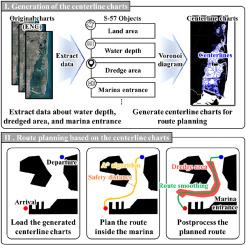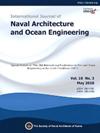码头内小型船舶航线规划方法
IF 3.9
3区 工程技术
Q2 ENGINEERING, MARINE
International Journal of Naval Architecture and Ocean Engineering
Pub Date : 2025-01-01
DOI:10.1016/j.ijnaoe.2025.100684
引用次数: 0
摘要
为码头内的小型船只规划安全有效的路线至关重要。然而,现有的航线规划方法主要是为商业船舶开发的,因此不能充分捕捉到小型船舶独特的航行特性。针对这一局限性,本研究提出了一种小型船舶在码头内航行的航线规划方法。该方法基于Voronoi图生成中心线图。在这里,Voronoi图是由综合海图生成的,它综合考虑了码头内的各种特征。然后,采用A *算法,结合水深来规划最优路线。此外,还引入了规划路线的后处理,以考虑疏浚面积和码头入口处港口到港口的通行规则,包括路线平滑。最后,将该方法应用于迈阿密地区附近的一个码头,以评估其有效性。结果表明,与现有方法不同,该方法在较短的计算时间内成功地考虑了码头入口的水深、疏浚面积和港对港通行规则,同时保持了与海岸线的安全距离。因此,预计该方法将提高小型船舶在码头内航行的安全性和效率。本文章由计算机程序翻译,如有差异,请以英文原文为准。

A route planning method for small ships inside the marina
Planning safe and efficient routes for small ships inside the marina is essential. However, existing route planning methods have been primarily developed for commercial ships and, therefore, fail to adequately capture the unique navigational characteristics of small ships. To address this limitation, this study proposed a route planning method for small ships navigating inside the marina. The proposed method generated centerline charts based on a Voronoi diagram. Here, the Voronoi diagram was generated from the integrated nautical charts, which comprehensively account for various features inside the marina. Then, the A∗ algorithm was applied by incorporating water depth to plan the optimal route. Furthermore, postprocessing of the planned route was introduced to account for the dredged area and the port-to-port passing rules at marina entrances, including route smoothing. Finally, the proposed method was applied to a marina near the Miami region to evaluate its effectiveness. The results demonstrate that, unlike existing methods, the proposed method successfully considers water depth, dredged area, and port-to-port passing rules at marina entrances while also maintaining a safety distance from the shoreline, all within a short computation time. Accordingly, the proposed method is expected to enhance the safety and efficiency of small ships navigating inside the marina.
求助全文
通过发布文献求助,成功后即可免费获取论文全文。
去求助
来源期刊

International Journal of Naval Architecture and Ocean Engineering
ENGINEERING, MARINE-
CiteScore
4.90
自引率
4.50%
发文量
62
审稿时长
12 months
期刊介绍:
International Journal of Naval Architecture and Ocean Engineering provides a forum for engineers and scientists from a wide range of disciplines to present and discuss various phenomena in the utilization and preservation of ocean environment. Without being limited by the traditional categorization, it is encouraged to present advanced technology development and scientific research, as long as they are aimed for more and better human engagement with ocean environment. Topics include, but not limited to: marine hydrodynamics; structural mechanics; marine propulsion system; design methodology & practice; production technology; system dynamics & control; marine equipment technology; materials science; underwater acoustics; ocean remote sensing; and information technology related to ship and marine systems; ocean energy systems; marine environmental engineering; maritime safety engineering; polar & arctic engineering; coastal & port engineering; subsea engineering; and specialized watercraft engineering.
 求助内容:
求助内容: 应助结果提醒方式:
应助结果提醒方式:


